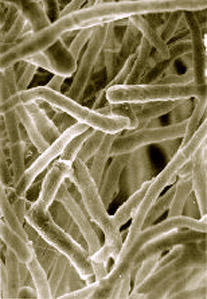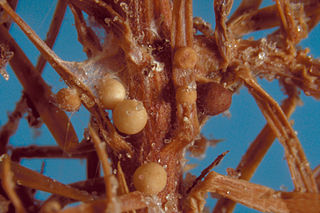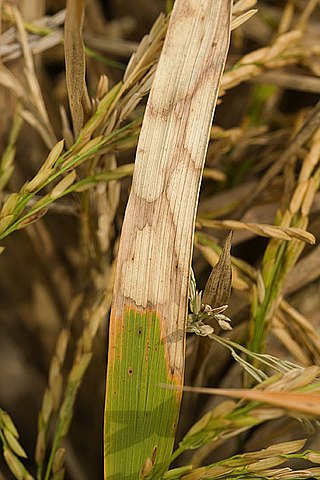Leaf mold is the compost produced by decomposition of shaded deciduous shrub and tree leaves, primarily by fungal breakdown in a slower cooler manner as opposed to the bacterial degradation of leaves.

Botrytis cinerea is a necrotrophic fungus that affects many plant species, although its most notable hosts may be wine grapes. In viticulture, it is commonly known as "botrytis bunch rot"; in horticulture, it is usually called "grey mould" or "gray mold".

Oomycota forms a distinct phylogenetic lineage of fungus-like eukaryotic microorganisms, called oomycetes. They are filamentous and heterotrophic, and can reproduce both sexually and asexually. Sexual reproduction of an oospore is the result of contact between hyphae of male antheridia and female oogonia; these spores can overwinter and are known as resting spores. Asexual reproduction involves the formation of chlamydospores and sporangia, producing motile zoospores. Oomycetes occupy both saprophytic and pathogenic lifestyles, and include some of the most notorious pathogens of plants, causing devastating diseases such as late blight of potato and sudden oak death. One oomycete, the mycoparasite Pythium oligandrum, is used for biocontrol, attacking plant pathogenic fungi. The oomycetes are also often referred to as water molds, although the water-preferring nature which led to that name is not true of most species, which are terrestrial pathogens.

Trichoderma harzianum is a fungus that is also used as a fungicide. It is used for foliar application, seed treatment and soil treatment for suppression of fungal pathogens causing various fungal plant diseases. Commercial biotechnological products such as 3Tac have been useful for treatment of Botrytis, Fusarium and Penicillium sp. It is also used for manufacturing enzymes.

Rhizoctonia solani is a species of fungus in the order Cantharellales. Basidiocarps are thin, effused, and web-like, but the fungus is more typically encountered in its anamorphic state, as hyphae and sclerotia. The name Rhizoctonia solani is currently applied to a complex of related species that await further research. In its wide sense, Rhizoctonia solani is a facultative plant pathogen with a wide host range and worldwide distribution. It causes various plant diseases such as root rot, damping off, and wire stem. It can also form mycorrhizal associations with orchids.

Damping off is a horticultural disease or condition, caused by several different pathogens that kill or weaken seeds or seedlings before or after they germinate. It is most prevalent in wet and cool conditions.
Microfungi or micromycetes are fungi—eukaryotic organisms such as molds, mildews and rusts—which have microscopic spore-producing structures. They exhibit tube tip-growth and have cell walls composed of chitin, a polymer of N-acetylglucosamine. Microfungi are a paraphyletic group, distinguished from macrofungi only by the absence of a large, multicellular fruiting body. They are ubiquitous in all terrestrial and freshwater and marine environments, and grow in plants, soil, water, insects, cattle rumens, hair, and skin. Most of the fungal body consists of microscopic threads, called hyphae, extending through the substrate in which it grows. The mycelia of microfungi produce spores that are carried by the air, spreading the fungus.

Trichoderma reesei is a mesophilic and filamentous fungus. It is an anamorph of the fungus Hypocrea jecorina. T. reesei can secrete large amounts of cellulolytic enzymes. Microbial cellulases have industrial application in the conversion of cellulose, a major component of plant biomass, into glucose.

Trichoderma is a genus of fungi in the family Hypocreaceae that is present in all soils, where they are the most prevalent culturable fungi. Many species in this genus can be characterized as opportunistic avirulent plant symbionts. This refers to the ability of several Trichoderma species to form mutualistic endophytic relationships with several plant species. The genomes of several Trichoderma specieshave been sequenced and are publicly available from the JGI.

Athelia rolfsii is a corticioid fungus in the family Atheliaceae. It is a facultative plant pathogen and is the causal agent of "southern blight" disease in crops.
Pythium aphanidermatum is a soil borne plant pathogen. Pythium is a genus in the class Oomycetes, which are also known as water molds. Oomycetes are not true fungi, as their cell walls are made of cellulose instead of chitin, they are diploid in their vegetative state, and they form coenocytic hyphae. Also, they reproduce asexually with motile biflagelette zoospores that require water to move towards and infect a host. Sexually, they reproduce with structures called antheridia, oogonia, and oospores.
Pyrenochaeta terrestris is a fungal plant pathogen infecting maize, sweet potatoes and strawberries. This plant pathogen causes a disease in onion that is commonly called Pink Root. This fungus is also known to infect shallot, garlic, leek and chive, cantaloupe, carrot, cauliflower, corn, cowpea, cucumber, eggplant, lima bean, millet, vats, peas, peppers, potato, spinach, sugarcane and tomato.

Fungivory or mycophagy is the process of organisms consuming fungi. Many different organisms have been recorded to gain their energy from consuming fungi, including birds, mammals, insects, plants, amoebas, gastropods, nematodes, bacteria and other fungi. Some of these, which only eat fungi, are called fungivores whereas others eat fungi as only part of their diet, being omnivores.
Chaetomium cupreum is a fungus in the family Chaetomiaceae. It is able to decay in manufactured cellulosic materials, and is known to antagonize a wide range of soil microorganisms. This species is component of the biocontrol agent, Ketomium, a commercial biofungicide. It has also been investigated for use in the production of natural dyes. Chaetomium cupreum is mesophilic and known to occur in harsh environments and can rapidly colonize organic substrates in soil. Laboratory cultures of C. cupreum can be propagated on a range of common growth media including potato dextrose at ambient or higher than ambient temperature producing cottony white colonies with a reddish reverse.

Rhizoctonia is a genus of fungi in the order Cantharellales. Species form thin, effused, corticioid basidiocarps, but are most frequently found in their sterile, anamorphic state. Rhizoctonia species are saprotrophic, but some are also facultative plant pathogens, causing commercially important crop diseases. Some are also endomycorrhizal associates of orchids. The genus name was formerly used to accommodate many superficially similar, but unrelated fungi.

Chaetomium globosum is a well-known mesophilic member of the mold family Chaetomiaceae. It is a saprophytic fungus that primarily resides on plants, soil, straw, and dung. Endophytic C. globosum assists in cellulose decomposition of plant cells. They are found in habitats ranging from forest plants to mountain soils across various biomes. C. globosum colonies can also be found indoors and on wooden products.
Trichoderma longibrachiatum is a fungus in the genus Trichoderma. In addition to being a distinct species, T. longibrachiatum also typifies one of several clades within Trichoderma which comprises 21 different species. Trichoderma longibrachiatum is a soil fungus which is found all over the world but mainly in warmer climates. Many species from this clade have been adopted in various industries because of their ability to secrete large amounts of protein and metabolites.
A mycoparasite is an organism with the ability to parasitize fungi.

Trichoderma koningii is a very common soil dwelling saprotroph with a worldwide distribution. It has been heavily exploited for agricultural use as an effective biopesticide, having been frequently cited as an alternative biological control agent in the regulation of fungi-induced plant diseases. They are endosymbionts associated with plant root tissues, exhibiting mycoparasitism and promoting plant growth due to their capacity to produce different secondary metabolites.

Rice-sheath blight is a disease caused by Rhizoctonia solani, a basidiomycete, that causes major limitations on rice production in India and other countries of Asia. It is also a problem in the southern US, where rice is also produced. It can decrease yield up to 50%, and reduce its quality. It causes lesions on the rice plant, and can also cause pre- and post-emergence seedling blight, banded leaf blight, panicle infection and spotted seed.












